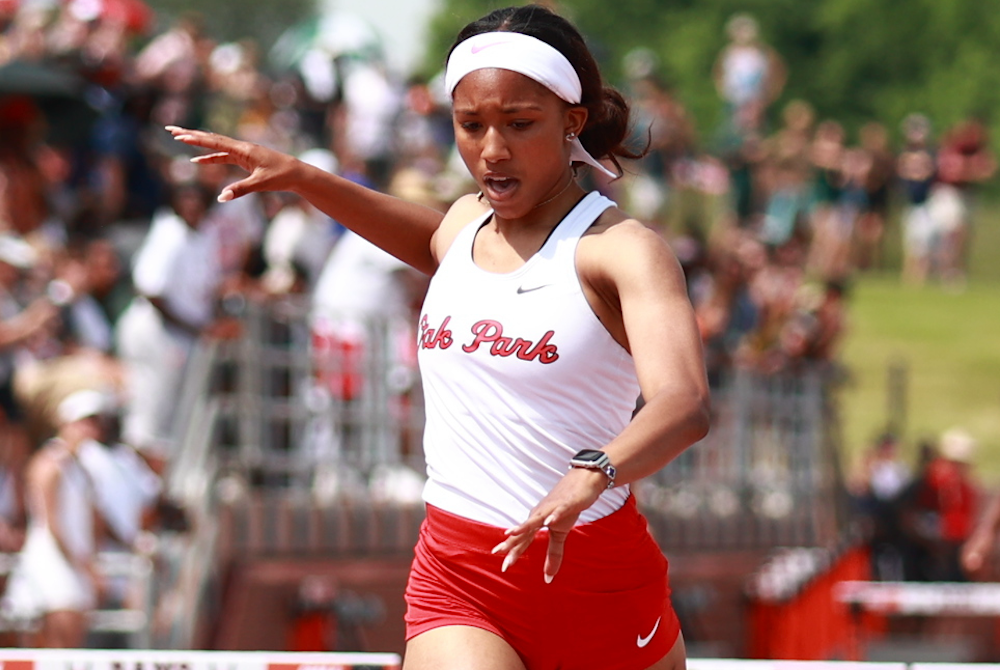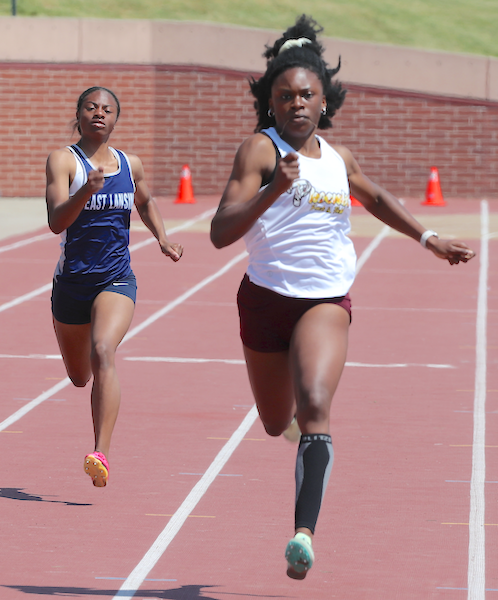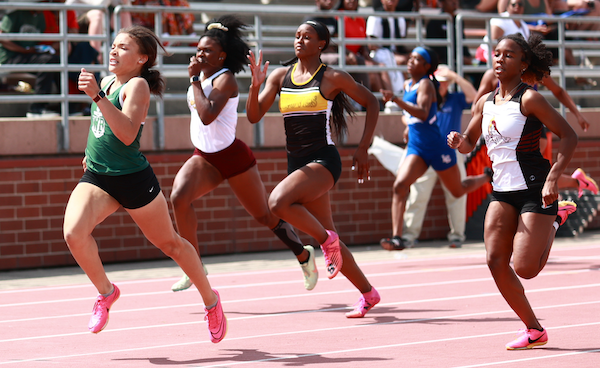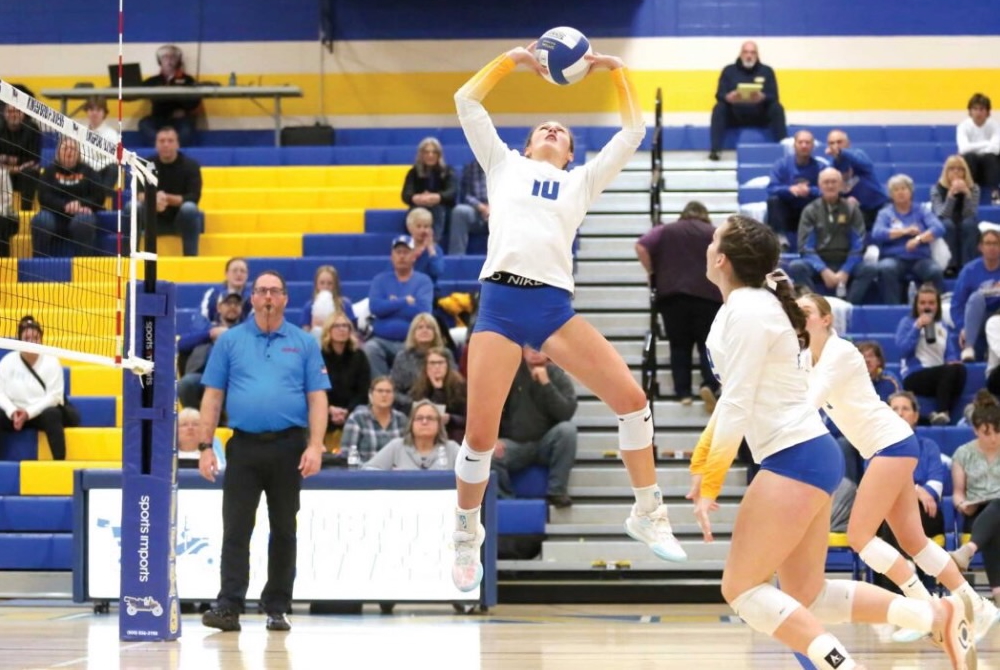
Oak Park Girls Hurdle Competition Again to Regain LPD1 Championship
By
Keith Dunlap
Special for MHSAA.com
June 3, 2023
ROCKFORD – For the fourth time in five seasons Saturday, Oak Park’s girls captured the Lower Peninsula Division 1 team title – this time with a meet-best 80 points at Rockford High School.
Last season’s champion Detroit Renaissance was second with 58 points, while Ann Arbor Pioneer was third at 56.
The Knights – runners-up a year ago – won again mainly thanks to their dominance in the hurdles. Senior Nonah Waldron won the 100 and 300 hurdles, but also Morgan Roundtree was third in the 100 (13.86) and second in the 300 (41.54) and Carrie VanNoy was fourth in both the 100 (14.18) and 300 (44.11).
Waldon said the team’s success was all about pushing each other the best they could in practice every day.
“It takes maturity to understand that you all can be great together,” Waldron said. “It took a lot of love for each other to be the best we can be.”
 The Knights also were second in the 400 relay (47.71) and 800 relay (1:38.21), and third in the 1,600 relay (3:55.27).
The Knights also were second in the 400 relay (47.71) and 800 relay (1:38.21), and third in the 1,600 relay (3:55.27).
“I think that dealing with losing and some adversity helps you grow,” Oak Park coach Brandon Jiles said. “I think the kids used the experience from last year to catapult them this year. We know it’s a points game. We know there are no style points in team championships. We spread the kids out to do what we needed to do. We’re not a depth team, but a quality team. They showed out, and I’m happy.”
Waldron won the 100 hurdles in a time of 13.56 before really putting on a show in the 300 hurdles. She won that event in a time of 40.37, which was the second-fast time in that event in the nation thus far this year. Waldron, who will run in college at USC, also won both hurdles events two years ago and won the 100 hurdles last year, but had a mishap that cost her last year’s title in the 300.
“Last year, I fell and tore my ankle,” she said. “That did motivate (me) a lot more than before. It made me want it more.”
If it wasn’t evident that Renaissance sophomore Jayla Dace might be the state’s next big sprinting star already, she established that on the biggest stage.
Dace won the 100-meter dash in a time of 11.90 and was a part of winning 400 and 800 relay teams. Dace also took third in the 200-meter dash in a time of 24.56.
“The starting gun is a horn, so I’m not really used to that,” Dace said of her strategy in the 100. “I had to really adapt quickly and to make sure I wasn’t the last person to get out of the blocks. Once you see people in the 100 ahead of you, it’s over. I just had to make sure when I started the race that I really didn’t see anybody.”
In the relays, Dace ran the second leg in the 400 and the first leg in the 800.
 “I’m just happy we were able to execute,” Dace said.
“I’m just happy we were able to execute,” Dace said.
Saturday was quite an inauguration into the pressure of a high school state meet for West Bloomfield freshman Kamryn Tatum. But she performed like a veteran, winning the 400 in a time of 55.74 and the 200 in a time of 24.10.
“I’ve been at big meets so I know how to deal with quite a bit of pressure, but I was still nervous because it was my first high school (Finals),” Tatum said. “I just wanted to run until the end of the line.”
Ann Arbor Pioneer junior Rachel Forsyth won the 800 (2:09.96) and 1,600 (4:44.22), and East Lansing senior Anna Delgado finished first in the 3,200 (10:33.87). Forsyth also was part of Pioneer’s winning 3,200 relay (9:01.19), and Detroit Cass Tech won the 1,600 relay (3:52.82) by 12 hundredths of a second ahead of Renaissance.
Howell senior Sophie Daugard was first in shot put (41-7), Allen Park junior Abigail Russell first in discus (148-7½), and Grand Rapids Forest Hills Central junior Brooke Bowers won pole vault (12-3). Farmington Hills Mercy junior Milena Chevallier won high jump (5-11), and Rockford senior Maya Anderson was champion in the long jump (18-6½). Flushing sophomore Ally Ingrahm competed in the adaptive 100 (42.81).
PHOTOS (Top) Oak Park's Nonah Waldron crosses the finish line first in the 100 hurdles Saturday. (Middle) Renaissance's Jayla Dace, right, charges toward the finish. (Below) West Bloomfield's Kamryn Tatum, far left, leads the 200. (Photos by Jamie McNinch [top photo] and Carter Sherline/RunMichigan.com.)

Kingsford's Kreider Prepared for Next Level After Finishing Stellar Flivvers Career
By
John Vrancic
Special for MHSAA.com
June 19, 2025
KINGSFORD — After completing a successful high school volleyball career, Maddy Kreider is ready to take the next step.
 The Kingsford senior is taking her talents to Michigan Tech, where she’s expected to continue primarily as a setter.
The Kingsford senior is taking her talents to Michigan Tech, where she’s expected to continue primarily as a setter.
“That will be a big step for sure, but it’ll be exciting being with the girls,” she said. “The girls are taller in college. It will definitely be an adjustment, physically and mentally. We’ll be traveling longer distances, and it’ll be a matter of improving the mental part of my game.”
Kreider was selected the Upper Peninsula’s Defensive Player of the Year her final two seasons after the U.P. Sportswriters and Sportscasters Association began voting for all-U.P. volleyball.
“That’s quite an accomplishment,” she said. “It’s a real honor playing with girls I grew up with. We had a great season.”
The 5-foot-8 setter was a four-year starter and two-year team captain at Kingsford, leading the Flivvers to three Division 2 District titles and back-to-back undefeated Great Northern Conference championships. She twice was named GNC Player of the Year.
She was also selected all-state first team in the fall and all-state second team in 2023, and all-region throughout her prep career. Her serving percentage also topped .900 throughout her four seasons on varsity.
 Last fall, the Flivvers reached the Regional Semifinal at Manistique where they dropped a 3-2 decision to Kingsley.
Last fall, the Flivvers reached the Regional Semifinal at Manistique where they dropped a 3-2 decision to Kingsley.
“I thought we’d get through,” Kreider said. “We came out lights out in the first two sets, then it was close in the last three.”
Also among the team’s highlights this past fall was a victory at Calumet, approximately 2½ weeks after dropping a 3-1 decision to the Copper Kings on Kingsford’s home floor.
“We wanted to play them,” Kreider said. “They’re a great bunch of girls to play against. They’ve been the measuring stick up here for many years. Winning on their floor was super exciting. We knew we had to play well just to be competitive. That was a great confidence builder for our group. We were definitely on a high going into the District.”
The Flivvers opened their postseason with a 3-1 triumph over Houghton, then defeated Escanaba in straight sets in the District Final.
Kreider will join Calumet senior Maddie Torola at MTU this fall. Torola, who recorded a season-high 19 kills in the four-set victory at Kingsford, helped the Copper Kings finish 29-5 and reach the Division 3 Regional Final at Sault Ste. Marie where they dropped a 3-2 decision to Traverse City St. Francis.
“It was fun playing against her in high school,” Kreider said. “It will be even more fun playing as teammates. It’ll be exciting to be playing on the same team.”
Both will be playing under new head coach Cindy Pindral at Tech. Both of Kreider’s parents played for the Huskies, her mother (and Kingsford varsity coach) Jaclynn volleyball from 1998-2002 and her father Jason basketball from 1997-2000.
Maddy Kreider recently earned an additional honor when she was selected Female Athlete of the Year for Kingsford’s Class of 2025. She recently completed a solid track & field season for the Flivvers.
At the U.P. Division 1 Finals, Kreider placed fourth in the 100-meter dash (13.2) and anchored the Flivvers to a third-place finish in the 800 relay (1:51.57) and fourth in the 400 (53.03) on their home track.
Kreider was named one of 32 MHSAA/Farm Bureau Insurance Scholar-Athlete Award winners this winter and plans to study exercise science and kinesiology at MTU.
 John Vrancic has covered high school sports in the Upper Peninsula since joining the Escanaba Daily Press staff in 1985. He is known most prominently across the peninsula for his extensive coverage of cross country and track & field that frequently appears in newspapers from the Wisconsin border to Lake Huron. He received the James Trethewey Award for Distinguished Service in 2015 from the Upper Peninsula Sportswriters and Sportscasters Association.
John Vrancic has covered high school sports in the Upper Peninsula since joining the Escanaba Daily Press staff in 1985. He is known most prominently across the peninsula for his extensive coverage of cross country and track & field that frequently appears in newspapers from the Wisconsin border to Lake Huron. He received the James Trethewey Award for Distinguished Service in 2015 from the Upper Peninsula Sportswriters and Sportscasters Association.
PHOTOS (Top) Kingsford’s Maddy Kreider sets for her teammates during a match last season. (Middle) Kreider, right, takes a photo with Kingsford’s Male Athlete of the Year Gavin Grondin. (Photos provided by the Kingsford athletic department.)

